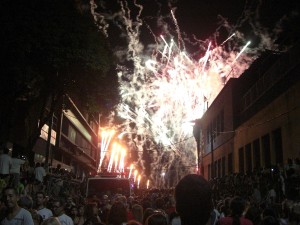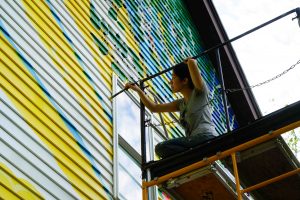An adapted version of this essay also appeared in the Isthmus.
A Common Council vote on funding for State Street businesses sparked debate over the city’s priorities amid Black Lives Matter protests, and marks a division in how our community understands racial justice. This is an ongoing issue and the Common Council meets again on September 1 at 6:30 pm. Make your voice heard! Join this meeting by registering at CityOfMadison.com!
Racial inequity and injustice ignited protests in Madison at the end of May. The police brutality continued, and now Kenosha has shown the country that nothing has changed. So here we are again. Protesting a system that values property over people. Enduring criticism from leaders who expect better behavior from the abused than from the abusers. In all of this, there is a story about the power of civic engagement. What would our leaders learn by prioritizing our community voice? How would things finally change for the better if the city and its citizens prioritized people and progress over megalomania and murder? How are you using your voice?
City government is unduly influenced by wealthy property owners, but much of the civic process is obscured from Madison residents. We need to show up to city meetings to disrupt the cycle. How do we do that? I have laid out the timeline of this recent debate to demonstrate how.
As a preface, on July 21, the Common Council rejected funding by a vote of 14-6 for the Downtown Recovery Program, which aimed to assist businesses in the State Street area that were vandalized during the protests starting in late May. The vote inspired a backlash of anger from some State Street business owners, and opinion pieces centered on businesses’ suffering. A second wave of protests on August 23-24 intensified this already splintered narrative. On one side is the suffering of businesses and the condemnation of violent protests. On the other side is the suffering of people and the justified anger of their pain.
The debate started in June, when Ald. Mike Verveer and Mayor Satya Rhodes-Conway proposed spending $500,000 for a Downtown Recovery Program. Some in the community pushed back on the city for prioritizing the use of public funds to repair private property while taking no meaningful steps towards racial justice. Activists were further angered by how quickly the city validated an anonymous letter from business owners calling for more surveillance and police presence downtown.
Verveer revised the proposal, adding a new Downtown Equity Program to make the proposal more appealing. The first public document for the equity program was made available less than 24 hours before the Economic Development Committee (EDC) was to review it on July 15. That meeting was canceled. The proposal skipped EDC’s review and moved forward to the Finance Committee on July 20 and the Common Council the next day.
A shocking 118 people registered at the Common Council meeting in opposition to the resolution; only eight registered in support. Some people showed up in response to social media posts by Urban Triage, Allies for Black Lives, and Madison for Black Lives; others were responding to independent calls to action, including ones I posted on social media.
The arguments in opposition were varied. Many of us spoke against taking money from public infrastructure projects to repair commercial buildings on State Street. People were angered that this was being done under the guise of helping small businesses, when it really would have benefited landlords who have continued to collect rent from shop owners hobbled by the pandemic.
Rent on State Street is some of the highest in the city, with one business owner testifying at the Common Council that it costs him $600 a day to stay open. Yet the gaslight has been to blame the city for troubles experienced by business owners, not the overpriced real estate which was a problem before the pandemic or the police whose excessive force incited civil unrest.
Others testified that providing more money to State Street, an area that has received a disproportionate amount of resources from the city, was an example of institutional racism. Shouldn’t we instead use public tax dollars to close social gaps by investing in neighborhoods that don’t have downtown’s fundraising engine? How does repairing windows and walls do anything to address the core issues which protestors identified in the first place?
Despite the number of people who registered in opposition to the Downtown Recovery Program, the Finance Committee nevertheless recommended the resolution to the Common Council, with Ald. Kemble being the only member to vote no. It turns out, this should have been expected.
One community member who spoke at the public meetings volunteered their time to dig through the records of every Finance Committee meeting in 2020. All 173 funding requests discussed by the panel this year were recommended for adoption or approval. Of 1,125 total votes cast, members cast “no” votes just 11 times; seven of those were related to State Street funding following public pressure. How many other proposals have passed without public scrutiny, that have perpetuated unequal funding across the city?
When a city prioritizes giving public dollars to private property owners capable of raising $200,000 in 24 hours (and who recently established a private Downtown Madison Fund to raise an additional $300,000 “to support the downtown businesses damaged by civil unrest”), it suggests that getting public money has less to do with need than with entitlement. It has everything to do with what downtown businesses think the city owes them.
There were also problems with the Downtown Equity Program. Verveer amended the proposal again, less than 24 hours prior to the July 21 Common Council meeting, removing the word “downtown” and changing funding sources with no fundamental change to the resolutions. The lack of transparency and last-minute addition of the Equity Program gave the impression that these changes were to make the State Street recovery program more palatable.
Furthermore, Downtown Madison representatives offered misrepresentative statistics when boasting about State Street’s diversity, noting that 62% of businesses are minority- and women-owned. Sixty-three of the 152 businesses on State Street are minority- and women-owned businesses — that comes to 41%. There are only 25 minority-owned businesses (16% of State Street and 6% of downtown) and no Black-owned businesses on State Street and downtown, a direct result of historic redlining and land grabbing.
Community members also pointed out that we are still in a pandemic, and that it is irresponsible to introduce new Black, Indigenous, People of Color (BIPOC) entrepreneurs downtown when existing businesses are struggling to survive. Entrepreneurship, without significant redistribution of wealth via reparations or change of property ownership, will do little to make downtown more equitable.
Ultimately, community input swayed more than one city council member to vote against the proposal. Ald. Marsha Rummel, who originally sponsored the Downtown Recovery Program, stated, “I did change my vote after listening to…members of the public. I also decided not to refer [this to the next meeting for revisions] after listening to Ald. Bidar.” Bidar, who also sided with the community, said that it felt like Downtown Madison representatives were using immigrant stories to push their agenda when it was convenient.
The debate continues. The Downtown Recovery Program returned to the Common Council on Aug. 4 and, for a third time, the documents the public had access to were out-of-date. Any good intentions are repeatedly clouded by a shady legislative process. The new revision now transfers $60,000 from an existing Facade Improvement Grant Program to use for downtown recovery, which frankly doesn’t make sense if businesses can just apply to the Facade program instead of shuffling the money under a new name. After another fraught debate (discussion in the linked video starts at 2 hours, 10 minutes) alders voted to refer the resolution to the Community Development Authority (CDA) Board. The amount of energy that has gone into this is exhausting, as is the inability of privilege to take “no” for an answer. The revival of this proposal is white supremacy in action.
I attended the CDA meeting, where multiple board members expressed either confusion or frustration over why this had been brought before them. Board members Greg Reed and Kelda Roys said that it felt like the CDA was being used as a pawn in an unpopular vote. Ultimately, only Claude Gilmore voted against $60,000 in funding, with most board members deciding to aid State Street with a “small amount of money” to put an end to the debate even if they disagreed with the premise of the funding. The Downtown Recovery Program will return to the Common Council on Sept. 1 for a final vote.
The overwhelming community response to city resolutions on property, as well as policing, sends a clear message, especially when considering how long, tedious and inaccessible city meetings are. The debate surrounding downtown recovery exemplifies a division and pivotal moment in how we understand racial justice. With that said, I do want to acknowledge downtown business owners such as Chef Tory Miller— whose response to the protests set an incredible example of how to genuinely center Black Lives Matter, not businesses, in the narrative. This is what solidarity looks like. Are we ready to recognize community labor and prioritize the public’s demands?Performative allyship is not good enough for us. We are a community calling for real systemic change. Equity as an afterthought is not good enough for us. We are a community calling for solutions to be centered on people and racial justice. We are a community that is showing up, because we believe this city can do much better. We are a community exercising our voice. Will you hear us?




